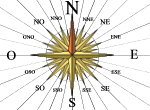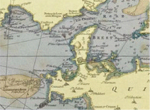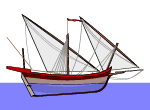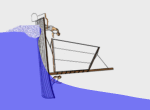
Glossaire anglais-français des termes de la marine ancienne 1780-1830
| A | B | C | D | E | F | G | H | I | J | K | L |
| M | N | O | P | Q | R | S-Sh | Si-Sz | T | U | V | WXYZ |
 |
 |
 |
 |
| G - dictionnaire anglais-français des termes marins, à l’intention des amateurs des romans historiques 1780-1830 | ||
| gaff: (1) a sloping spar attached to a mast at one end to support the head of a gaff, spanker or driver sail. The lower end moves in contact with the mast (2) fore-and-aft rig - see sail > gaff sail |
(1) corne (nf, espar placé en oblique et tenant la partie supérieure d’une voile aurique. L’extrémité inférieure s’appuie sur le mât et glisse sur celui-ci) (2) voile aurique - voir voile > voile à corne |
|
| gaff jaws (crescent-shaped piece at one end of the yard of a gaff-rigged boat. The concave side engages with the mast when the yard is hoisted) | corne de vergue (nf, « concavité en forme de croissant qui est au bout de la vergue d'une chaloupe et qui embrasse le mât lorsqu'on hisse ») | |
| gage - see weather gage | voir vent - avoir l'avantage du vent | |
| galley: (1) area for preparing and cooking food (2) rowing galley, a ship propelled by oars and sail, already archaic by the 18th century. The galley was rowed by galley-slaves who were usually convicts. See vessel comparison chart |
|
(1) coquerie (nf, cuisine, lieu où l’on prépare et fait cuire les aliments. Voir aussi cambuse) (2) galère (nf, navire propulsé à l’aviron et à la voile, déjà archaïque au XVIIIe siècle, la galère est mue par des galériens généralement condamnés. Voir tableau comparatif des bâtiments) |
| galleon (large, heavy Spanish ship of war, square-rigged and with three or four masts) | galion (nm, vaisseau de guerre espagnol, grand et lourd, à trois ou quatre mâts à voiles carrées) | |
gangway: (1) "In large ships it is the part of the deck, to port or starboard, which runs from the quarterdeck to the fo’c’sle (7 or 8 feet wide)" (2) entry port (an opening in the side of a ship which gives access to the gangway steps) |
(1) passavant (nm) « Dans les grands bâtiments c'est la portion du pont, tribord et bâbord, qui conduit du gaillard d'arrière au gaillard d'avant (d'une largeur de 7 à 8 pieds)» (2) coupée (nf, ouverture faite dans la muraille par laquelle on communique à l'échelle hors le bord) |
|
| gangway steps "steps which are nailed outboard of the ship, some two feet long, others three feet long, four to five inches deep, partly cut away inside. They are placed port and starboard at the level of the mainmast. They act as a ladder for those going up and down the side". |
échelle hors le bord «des espèces de marches clouées en dehors du bâtiment, longues, les unes de deux pieds, les autres de trois, et épaisses de quatre à cinq pouces, en partie évidées en dedans; on en a, tribord et bâbord par le travers du grand mât ; elles servent de marche-pieds pour monter et descendre le long du bord.» | |
| gasket (short length of line used, for example, to keep a sail furled) | garcette, raban de ferlage (nm, petit cordage d’une certaine longueur qui sert par exemple à ferler une voile sur sa vergue) | |
| to get under way (to carry out the activities needed to sail away, including setting sail and either raising the anchor or letting go the moorings) | appareiller (v, faire les manœuvres nécessaires pour que le voilier puisse partir: hisser les voiles, lever l'ancre, larguer les amarres) | |
| gig (light, slim, long, shallow-draught boat, usually rowed, for between four and ten oarsmen) | yole (nf), canot du capitaine (nm). ; embarcation légère, effilée et allongée, d'un faible tirant d'eau, propulsée généralement à l'aviron, qui arme quatre à dix avirons | |
| gingerbread work (carved and gilded wood, especially the stern carving) | bois sculpté et doré, surtout le tableau arrière et couronnement | |
glass: (1) glass (2) telescope (2) thirty-minute hourglass |
|
(1) verre (nm) (2) lunette, longue vue (nf) (2) sablier de trente minutes |
| to go about (to change tack, by putting either the stern or bow through the wind; a manoeuvre in which a ship is made to point directly upwind or downwind so that it can proceed with the wind coming from the other side. A sailing vessel is on the port tack when it receives the wind from the port side, which is the vessel’s left side when looking forwards. The starboard tack is the opposite) | virer de bord (v, changer d’amure, soit vent arrière, soit vent debout; manœuvre consistant à franchir le lit du vent, de manière à recevoir le vent du bord opposé à celui qui le recevait précédemment. Un voilier est à bâbord amures s’il reçoit le vent de bâbord, c’est-à-dire de son côté gauche en regardant vers l'avant. Tribord amure, c’est l’envers) | |
| go about > to tack (to turn the ship's head into the wind until it can proceed on the other tack, in other words its sails fill from the other side) | virer de bord vent debout (v). Virer vent devant; changer de route au point où le navire reçoit le vent de l'autre côté, en passant par le lit du vent (vent de face) | |
| go about > to wear ship (to go about with the wind from behind; to change course to such an extent that the wind is on the other side of the ship, in such a way that halfway through the manoeuvre, the ship faces directly downwind) | virer lof pour lof , virer de bord vent arrière (v, changer de route au point où le navire reçoit le vent de l'autre côté, en passant par l'allure de vent arrière) | |
| go about > to miss stays (to be in irons when attempting to tack; the ship is now head to wind, stationary or drifting, without being able to pay off on the new tack) | manquer à virer (résultat d'un virement de bord vent debout raté; le navire se retrouve dans le lit du vent, immobilisé ou dérivant, sans parvenir à repartir sur la nouvelle amure) | |
| go about > "Ready about!" (order to send the men on watch to the ropes when the ship is to tack or wear) | « Pare à virer!» (commandement pour disposer les hommes de quart aux manœuvres à l'instant où on veut faire virer de bord) | |
| go about > tacking > “Mainsail haul! | « Change derrière! » (ou décharge derrière) | |
| go about > tacking “Let go and haul!” | « Change devant! » (ou décharge devant) | |
| gold lace, braid, stripe, band (on uniform) | galon d’or (nm) | |
| gooseneck (metal joint which attaches a spar to a mast) | vit de mulet (nm, ferrure articulée qui relie un espar à un mât) | |
| grape shot (small projectiles fired simultaneously from a cannon and producing the effect of a shotgun; see also canister and case) | mitraille (nf), raisins (nm): petits projectiles tirés par un canon et produisant l'effet d'un fusil de chasse ; voir aussi boîte à balles | |
| grapnel, grappling hook | grappin, grapin, croc d'abordage (nm) | |
| grating (wooden grid used to cover a hatch) | caillebotis (nm, treillis de bois recouvrant l'ouverture d'une écoutille) | |
| griping (weather helm; tendency of a sailing vessel to turn upwind rather than stay on course. See also lee helm) | ardent (adj, se dit d’un voilier ayant tendance à lofer plutôt qu’à garder son cap. Voir aussi mou) | |
| grommet, grummet (ring of rope) | erse (nf), erseau (nm), anneau de cordage | |
| ground (sea bed - see bottom) | fond (nm, fond de la mer) | |
| groundswell | lame de fond (nf) | |
| guard (sentry) | factionnaire (nm, sentinelle) | |
| guard boat (harbour patrol boat) | canot de ronde (canot de patrouille en rade) | |
| guardrail (banister, safety rail) | rambarde, lisse (nf, appui, garde-fou) | |
| gudgeon (hinge socket with two arms for attachment to a boat's sternpost or to the rudder blade; the pintle slides into it) | fémelot (nm, penture à deux branches embrassant l'étambot ou le gouvernail et représentant des logements pour recevoir les aiguillots) | |
| gulf - see coastline | golfe - voir rivage | |
| gun. "The English use the word gun for any ship's cannon" - but see cannon | pièce d’artillerie. « Les anglais appelle gun tous les canons marins » - voir canon | |
| gunboat (a boat rigged as a brig but which can also make progress under sweeps, not generally suitable for use at sea even inshore, but which carries one or two thirty-six pounder guns) | canonnière (nf, chaloupe canonnière; embarcation mâtée et voilée en brigantin, allant aussi à l'aviron, peu propre à la navigation, même des côtes, mais qui porte un ou deux canons de trente-six livres) | |
| gun captain | chef de pièce (nm) | |
| gun carriage - see cannon | affût - voir canon | |
| gun deck (deck that carries guns; all the guns of one deck of a ship) | batterie (nf), pont-batterie (nm), ensemble de pièces d'artillerie se répartissant sur un pont-batterie | |
| gunlock. See cannon > gunlock | platine à silex pour canon. Voir canon > batterie à percussion | |
| gunner (master gunner, ship’s gunnery officer) | canonnier (nm, maître canonnier d’un navire) | |
| gun port, port hole (square openings in the side of a ship through which the guns fire. See also port-lid) |
|
sabord (nm, ouvertures carrées, ménagées dans la muraille d'un navire pour permettre aux canons de faire feu. Voir aussi mantelet) |
| gunpowder - see also magazine | poudre à canon (nf) | |
| gunroom, gun-room (part of the ship containing living accommodation for the gunner, clerk, purser and surgeon; petty officers' mess, wardroom for junior officers) | Sainte-Barbe (partie du navire où se trouvent les logements du maître canonnier, de l'écrivain et du chirurgien; carré des officiers subalternes) | |
| gunwale, gunnel (horizontal band of wood at the top of the hull planking; the thickest plank of all) | plat-bord (nm, ceinture horizontale en bois surmontant le bordé d'un navire; la virure la plus épaisse du bordé) | |
| to gybe or jibe (of a vessel with fore-and-aft rig, changing tack by turning away from the wind until the mainsail moves across to the other side) | empanner (v, d'un voilier à gréement aurique, faire passer la grand-voile d'un bord à l'autre en virant de bord vent arrière) | |
| H- dictionnaire anglais-français des termes marins, à l’intention des amateurs des romans historiques 1780-1830 | ||
| hailing distance, within | à portée de voix | |
| half-pay (the reduced pay of an officer left without employment) | demi-solde (nf, la solde réduite d'un officier rendu inactif, un officier réformé) | |
| half-pay officer (a naval officer without employment) | officier réformé (officier de la marine rendu inactif, en demi-solde) | |
| half-pike or halberd (edged weapon on a pole) | esponton ou demi-pique (nm, une arme composée d'une lame métallique fixée au bout d'un manche) | |
| halyard, halliard (a rope used to hoist a yard, gaff, sail or flag) | drisse (nf, cordage servant à hisser une vergue, une corne, une voile ou un pavillon) | |
| hammock | hamac (nm), branle (nm) | |
| hand (sailor, member of the crew) | matelot (nm), membre de l’équipage | |
| "All hands on deck!" | « Tout le monde sur le pont!» | |
| hand-spike (long oak lever used to shift a ship's guns) | anspect, barre d’anspect (nm, grand levier en chêne qui sert à la manœuvre des canons) | |
| "Handsomely!" (slowly, carefully) | « Doucement !» | |
| hanging cot (officer's bed aboard ship. See also cot and hammock) | lit-hamac (nm, couchette à l'usage d'un officier. Voir aussi cadre et branle) | |
| harbour-master (port), master attendant (dockyard) | capitaine de port (nm) | |
| hatchway (square opening in the deck giving access to the tweendecks and hold) | écoutille (nf, ouverture rectangulaire dans le pont pour accéder aux entreponts et aux cales | |
| hatch cover | panneau (nm) | |
| to haul (to pull hard): (1) to haul on a rope (by hand) (2) to haul in a rope using a winch of capstan (3) to haul taut (for example to tighten the lanyard joining two deadeyes in order to set up or tension the shrouds, or a stay) (4) to haul the wind - see point of sailing (5) to haul down a flag |
haler (v, tirer fortement): (1) embraquer (v, reprendre un cordage à la main) (2) virer (reprendre un cordage au moyen d’un cabestan ou d'un guindeau) (3) rider (v, tirer sur un cordage pour le raidir. Se dit surtout des haubans ou d'un étai) (4) remonter contre le vent (5) affaler un pavillon |
|
| "Haul in!" | « Virez l'amarre! » | |
| hawse (scope of anchor cable; the length of cable deployed in order to anchor a ship) | touée (nf, la longueur du câble mouillé pour ancrer un navire) | |
| hawse-hole (hole near a ship's bows through which the anchor cables pass) | écubier (nm, trou percé à l’avant d’un bâtiment pour y faire passer les câbles de mouillage) | |
| hawser (a thick rope) | haussière, aussière (nf, un gros cordage) | |
| head (crew's privy; see also quarter gallery and beakhead) | poulaine (nf, lieu d'aisance de l'équipage ; voir aussi bouteille) | |
| head - see sail > element | point de drisse - voir voile > élément | |
| head or heading of a vessel (the direction in which the bow is pointing. See also course) | cap (nm, la direction où pointe l'étrave d'un vaisseau. Voir aussi route) | |
| to heave (to haul or pull) | haler, embraquer, virer, souquer | |
| "Heave !" (order to haul on a rope together) | « Souque !» (commandement de tirer ensemble sur un cordage) | |
| to heave a line (throw somebody a rope - see heaving line) | lancer le bout d'une manœuvre - voir ligne d'attrape | |
| to heave down (to careen a ship by laying it over on its side, either afloat or at low tide, so as to be able to repair or caulk parts normally underwater) | abattre en carène (v, caréner; coucher un navire sur un de ses flancs afin de pouvoir travailler sur sa carène, à flot ou à marée basse) | |
| to heave taut (rope) | souquer, rider (v, tirer fortement sur un cordage) | |
| to heave the log - see log | filer le loch - voir loch | |
| to heave to (to stop a sailing ship without taking in sail, mainly by causing some sails to fill with wind from the wrong side ("backing the sails") so that their pushing force balances the pulling force of the other sails) | mettre en panne (v). Immobiliser un voilier tout en gardant sa voilure haute, en mettant notamment certaines voiles à contre («masquer les voiles») de telle sorte que leurs poussées respectives se contrarient. | |
| heaving line | lance-amarres (nm, ligne d'attrape) | |
| heel (sideways lean of a ship under the influence of wind or distribution of load. See also list) | gîte (nf, bande ; inclinaison du navire sur le côté sous l’effet du vent ou de la charge) | |
| heeling moment (see also righting moment) | couple de chavirage (voir aussi couple de redressement) | |
| helm (lever or wheel giving control over the rudder of a ship) | barre (nf, un levier ou une roue permettant de contrôler le gouvernail d’un navire) | |
| helm > ship's wheel | barre à roue (d'un navire) | |
| helm > boat's tiller | barre franche (d'un bateau) | |
| helm > "Up helm!" (put the helm to windward) | « Barre au vent !» (mettre la barre du gouvernail au vent) | |
| helm > "Helm-a-lee!" (put the helm to leeward) | « Barre dessous !» (mettre la barre du gouvernail sous le vent) | |
| helm > "Hard-a-starboard !" | « Tribord toute !» | |
| helm > "Meet her!" | « Rencontrer!» | |
| helm > "Keep her at that!" or "Steer as she goes!" | « Gouverne où tu as le cap!» | |
| helm > "On course!" | « Le cap en route!» | |
| helm > "Steer small!" | « Gouverne sans donner beaucoup de barre!» | |
| helm > lee helm (tendency of a sailing vessel to turn downwind rather than stay on course) | mou (adj, se dit d’un voilier ayant tendance à abattre plutôt qu’à garder son cap | |
| helm > weather helm, griping (tendency of a sailing vessel to turn upwind rather than stay on course) | ardent (adj, se dit d’un voilier ayant tendance à lofer plutôt qu’à garder son cap) | |
| helm > helmsman. The man who steers: (1) a ship, according to the captain's orders (2) a boat |
marin chargé de la barre : (1) d’un navire et qui gouverne aux ordres du capitaine (timonier, nm) (2) d’un bateau (barreur, nm) |
|
| hemp | chanvre (nm) | |
| hermaphrodite brig (brigantine; a small brig which has square sails on the foremast and fore-and-aft sails on the mainmast) | brigantin (nm, brick-goélette; petit brick qui porte des voiles carrées au mât avant et des voiles auriques au mât arrière) | |
| to hog (said of a keel which curves the wrong way; a ship is hogged when its ends are lower than its middle) | arquer (v, se dit d’une quillle courbée en sens contraire; « un bâtiment est dit arqué lorsque ses extrémités sont abaissées a l'égard du milieu de sa longueur ») | |
| hold of a ship (the compartment in which the cargo is stowed) | cale (nf, compartiment d'un navire dans lequel la cargaison est arrimée | |
| to holystone (to clean the deck by scrubbing it vigorously with a holystone) | briquer (nettoyer le pont du navire en frottant vigoureusement avec une brique à pont) | |
| hourglass. "divides the day into 48 parts, not in truth with any great accuracy, but enough for changes of watch and meal times". See also bell and log. | sablier (nm). « divise le jour en 48 parties, d'une manière peu exacte à la vérité, mais suffisamment pour les changements de quart et les repas ». Voir aussi horloge et loch | |
| howitzer - see army | obusier - voir armée de terre | |
| hoy: (1) a small sailing vessel used for coasting or to resupply ships at sea (2) water hoy (small vessel rigged with a single square sail on a central mast, used to carry fresh water to ships at anchor) |
(1) heu (nm, un petit navire, caboteur ou ravitailleur des navires en mer (2) citerne (nf, petit navire gréant une voile carrée sur un mât central, et qui sert à porter de l'eau douce aux bâtiments en rade |
|
| to hug: (1) to hug the wind (to sail upwind, close-hauled) (2) to hug the coast (to sail along very close to the coast) |
serrer (v): (1) serrer le vent (remonter contre le vent au plus près) (2) serrer la côte (longer la terre de plus près) |
|
| hulk (dismasted ship - see sheer hulk and prison hulk) | ponton (nm, navire démâté - voir ponton-mâture et ponton-prison) | |
| hull (the ribs and frames of a ship's structure, and the planking that covers it) | coque (nf, ensemble de la charpente d'un navire, et de son revêtement extérieur appelé «bordé») | |
| hull down (describes a distant ship with its hull over the horizon, so that one can see only its rigging above the horizon) | la coque noyée (se dit d’un navire lointain dont la coque est masquée par l'horizon; on ne voit que le gréement dégagé de l'horizon) | |
| hull up (describes a ship that is close enough for her hull to appear above the horizon) œuvres mortes dégagées de l'horizon | la coque visible (se dit d’un navire lointain dont les œuvres mortes sont dégagées de l'horizon) | |
| to hull (to make a hole in the side of an enemy ship) | saborder (v, percer la muraille d'un navire ennemi) | |
| hussar - see army | hussard - voir armée de terre | |
| I - dictionnaire anglais-français des termes marins, à l’intention des amateurs des romans historiques 1780-1830 | ||
| in irons (said of a sailing craft that is caught head to wind, unable to pay off). See also to miss stays | bloqué dans le lit du vent (se dit d'un voilier qui se trouve immobilisé, vent debout). Voir aussi manquer à virer | |
| island - see coastline | île, îlot - voir littoral | |